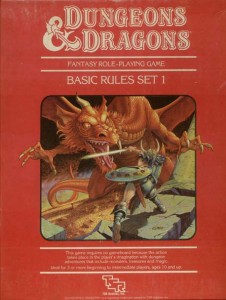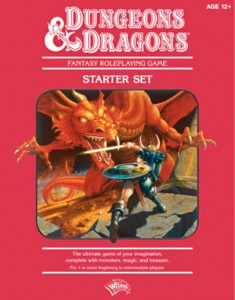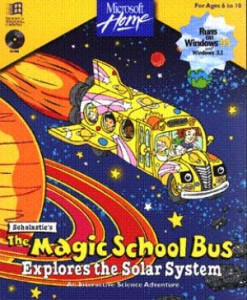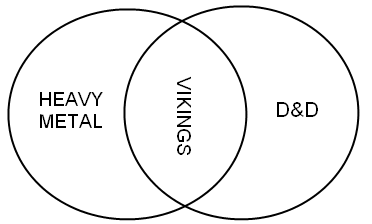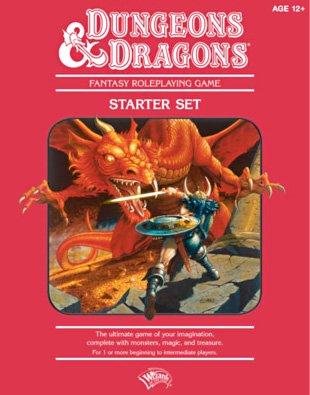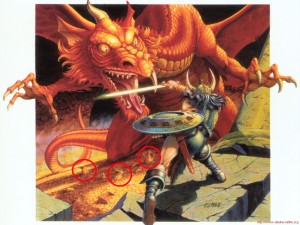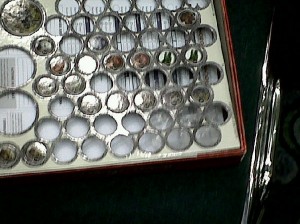Also, the 1983 set is for 3+ players, 10 and up. The new set is for 1 or more players. In the top right corner it now says “Age 12+”. But you know what? I bet 11 year olds would still like it.
Archive for the ‘4e D&D’ Category
Red Box differences
Saturday, August 28th, 2010Elmore today
Saturday, August 28th, 2010liveblogging D&D Essentials Starter
Saturday, August 28th, 2010The new Essentials Red Box is bigger than the 1983 Mentzer Red Box. The box is the same height and width, but about 50% deeper. Mentzer D&D just required the two booklets, dice, marker crayon, and MY IMAGINATION. The new box packs two booklets, dice, power cards, tokens, maps, and also, presumably, MY IMAGINATION. There’s also a large triangular cardboard insert propping up all the components, which has the effect of making the box look fuller than it is. Without it, everything would fit in a Mentzer-sized box. I guess the cardboard insert is to protect MY IMAGINATION from getting crushed during shipping.
D&D 4e Post Errata House Rules
Wednesday, August 25th, 2010UPDATE 9/21/2010: I changed the Expertise section to make it so players get a new feat called Expertise as a bonus feat at 1st level that gives a +1 feat bonus to all attacks per tier. Similar feats may not be taken.
UPDATE 9/12/2010: With the advent of Essentials feats and some more thought in general, I’ve made some tweaks to this list of house rules. Expertise, Item Bonuses to Damage, and Item Properties got updated, and I made a new entry for Damage Focus.
I realized my old house rules list was a little outdated since the latest errata, so I’ve created this new one instead.
This errata includes many of the item changes I hinted at in Item Issues. I should note that many of the item changes might not qualify strictly as errata with the new item rarity rules (since the DM has a lot of control over what items are given out), but could instead be considered as advice regarding which items tend to be very powerful and should be given out sparingly if at all:
- Expertise: All players get a feat called Expertise at 1st level that gives a +1 feat bonus to attacks per tier. No other Expertise feats may be taken. Reason: The Expertise feats are must takes for every character, which makes them boring. Also, they were included to fix a problem with attack bonuses not scaling properly with defenses so they might as well be inherent abilities. This house rule allows non weapon/implement attacks to benefit from the attack bonus too, such as racial attacks, and it supports the use of multiple weapons and implements. I considered allowing players to get bonuses from the new feats in Heroes of the Fallen Lands but decided against it since the feats don’t balance very well with each other and because that’s a lot of a punch to get with a bonus feat. Updated: 9/21/2010.
- Item Bonuses to Damage: All items that give an item bonus to damage no longer do so (making most such items useless). However, all PCs have a trinket that they acquired early in their adventuring career. The trinket takes up no slot (unless it’s something that would, like a hat), and it gives a +1 item bonus to damage per tier. If a PC loses the trinket somehow (if it is stolen from them, for example, or they give it away), the PC may not acquire a new trinket until they level up. Reason: Items that give item bonuses are super powerful and basically must haves for every class. Furthermore, different items give different item bonuses to damage, making for discrepancies in how much damage a class can do with certain weapons/implements. However, I don’t want to ban this entirely since more damage means faster combats, which is usually nice. Plus, I like the idea of players having a personal item that gives them strength, and which they may have had since the beginning of their adventuring life! Updated: 9/12/2010. (more…)
earn your magic perks
Tuesday, August 24th, 2010The more I think about it, the more I think the Essentials magic item rarity system is a huge game fix.
Common Items: no more socks for Christmas
Let’s take a 16th-level party. +3 weapons, armor and amulets are necessities. But all other magic item abilities are perks. D&D is a game about earning perks. In a game about earning perks, we don’t give out unearned perks.
Right now, characters have access to every item, and because players can spend a lot of time poring over the Character Builder, they always end up starting with, or buying, their capstone item. Once someone has the +2 Sword of Meshing Perfectly With Their Other Broken Abilities, no other +2 sword is going to interest them. In fact, they might prefer it to any +3 sword (except the +3 Sword of Meshing Perfectly With Their Other Broken Abilities). A DM has no way to please players but by staying on-wishlist, which is boring. Wishlists limit the number of D&D items in the universe from about a million to about 20.
As a DM, when I’m placing treasure, I’m thinking about what perks to give my players. If every character starts with a +2 weapon or implement with no abilities, I know that a +2 weapon, with any ability, will be valued. As it is, though, I often place cool items all over the dungeon; players find them; they decide their current gear is better; and everyone gets a “socks-for-Christmas” letdown.
Now, with players will be able to buy only generic, +x items, they no longer have the ability to ruin Christmas for themselves.
Rare items: cutting the Gordian cake and eating it too
From the article:
The rules assume that the DM hands out one rare item per character per tier. Rare items are meant to be character-defining, powerful objects that help forge the character’s identity in the world. If you find a flame-tongue weapon, you’ve uncovered an important, powerful blade.
People have been long complaining that they want fewer, more meaningful magic items. That’s always been a problem, though, because frequent magic-items drops are one of the big D&D rewards. If Rare items are really character-defining and once-per-tier, then we can have our cake and eat it too: we have a nifty way of giving the epic Excalibur items while still being able to dole out the routine magical junk that gets people back into the dungeons.
Conclusion
So far, the 4e magic system has been very efficient and sturdy without being very exciting, like a German-engineered school bus. I feel like it’s getting an upgrade:
Skills in D&D 4e – Some Simple Math
Monday, August 23rd, 2010I was looking through this thread on the wizards forums and it got me thinking about skills in D&D 4e again. The thread was started in response to the Dragon article by Mike Mearls about Item Rarity. One of the complaints some people mentioned was that with new item rarities, players are basically restricted to minor stuff that give skill bonuses. Thus, skill DCs for skill challenges and other checks will be even crazier and wacky as players fill their slots with skill boosting items.
The thing is, skills have already been like this! Between training, ability scores, backgrounds, racial bonuses, powers, and items, the range of skill modifiers is way to wide to really work for any given DC. The only thing that is really sure is that the current DCs are too low!
Some simple numbers to illustrate my point: (more…)
(more…)
D&D 4e Item Issues
Wednesday, August 18th, 2010One of the announcements at Gen Con was that with the release of essentials items will now come in three rarities: common, uncommon, and rare. To summarize:
- Rare items can’t be created by players. They’re very special, and the general idea is that a player will have maybe one of these in their possession at any given time.
- Uncommon items also can’t be created by players, and are the purview of the DM with maybe a few exceptions. Pretty much all magic items currently available are going to fall into this category (though I suspect your basic “magic item +X” will be common.
- Common: These are easily purchasable and can be created by players. Again, my suspicion is that these are things like a basic magic item with no frills.
Revisiting items has gotten me thinking about the philosophy change behind items from 3.5 to 4th edition:
- Christmas Tree Effect: 3.5 suffered from the Christmas tree effect, where players were often more defined by their items than by their abilities. A mid to high level character had a long list of items for boosting various defenses and stats that they basically had to go through to have a viable character. 4e is supposed to solve this by condensing the items a player HAS to take to just a few. Everything else is supposed to be supplementary, adding a cool power or property here or there but not overwhelming anything.
- Items are special: An added bonus of this is supposed to be that items now feel more special. A +3 flaming sword is a lot cooler if it’s one of my three major magic items rather than one out of twelve or thirteen items I have on my check list as must haves.
So the question is, has 4e succeeded in this noble goal of cutting down the number of items a player needs and making them feel more unique?
My Answer: Yes, but only because the bar was set pretty low by 3.5. A character not only basically require a lot more items than it might appear at first glance, but certain items can dramatically effect the balance of a character, favoring certain builds more than they probably should.
I go through the goods and bads of items in 4e below: (more…)
D&D: vikings with ewers
Tuesday, August 17th, 2010Inspired perhaps by Greywulf’s badass Thor cleric build from the D&D Essentials cleric preview, I’ve decided to run our Essentials trial game in the viking/Beowulf milieu. Somehow, I have never actually played in a viking game, although it is so 80’s D&D, as illustrated in the following Venn diagram:
With the Essentials Starter Set leaning on the early-D&D nostalgia button (reintroducing the terms “thief” and “backstab”, for instance) I think it’s time to pump up some Viking metal and prepare to journey from the frozen North.
Speaking of 80s nostalgia and Vikings, take another look at the cover of the D&D Essentials Starter set (which uses the same art as the 80s red box).
Look at that guy fighting the dragon. Look at his horns. They’re like 2 feet long. That guy is a viking. If you’re not playing viking D&D, you’re Doing It Wrong.
This illustration is so classic 80’s D&D that it should really serve as a road map to my Viking adventure. Besides the viking, we have a dragon – a strange-kneed dragon – and the setting is a dungeon floor of tumbled stones, with a vast treasure piled in the rift. Classic!
Take a look at the composition of the treasure though. The predominant treasure type is gold… glittering gold. As it should be. Then there’s what looks like a potion… a chest… and no less than three jugs.
Are they jugs? Pitchers? Vases? Decanters? I think when they’re in treasure, they might be called ewers? Anyway, there are an excessive number of ewers in this dragon’s hoard.
(more…)
Rory’s Pocket Guide to D&D 4e – Playing Combat
Sunday, August 15th, 2010I gave you some handy tips for Character Creation!
I set you straight on Roleplaying!
Now let’s focus on combat!
Combat
Combat in D&D is its own beast, and there are a lot of things to keep in mind when making decisions. In D&D 4e, the increased complexity can make for longer combats, so staying alert and knowing what to do is important!
- Make a game plan: When a combat starts and as it evolves, you should be making a game plan for how the encounter will be playing out. A few good questions to run through: Is this going to be a tough combat or is it just meant to drain my resources? Is there terrain I can take advantage of? What monsters should I be targeting? Should the party be staying close together or spreading out? Are there certain abilities that are going to be in high demand this combat, such as movement abilities, extra healing, and extra saving throws or bonuses? Being able to answer these questions will play a huge part in what resources you use and which abilities you know to keep track of so you aren’t left floundering when it comes time to act.
- The Three Action Tango: During other players’ turns you should usually be planning the three actions you’ll take on your turn: Standard, Move, and Minor. Obviously, you may need to reassess when your turn comes around since enemies might die or move around, but even a rough plan is VERY useful and will help the game run smoothly. For standard actions, you’re almost always looking at an attack power, so look through your encounters first and see if any are particularly appropriate; there is NO reason to be stingy with encounter powers. If not, turn to your trusty at-wills. If the fight is looking like it will be very difficult, go ahead and pop a daily if it will help the encounter significantly, since many have encounter long effects that will be more useful at the beginning of the battle than later on. For move actions, well, movement is pretty obvious, though keeping in mind that you can swap down to a minor is a good thing to do, especially for wizards who sometimes have multiple effects that they need to sustain. Think about where you’re going to need to move to get the best attack off, avoid dangerous situations, and get flanking bonuses. Finally, always think about something to do with your minor action. This will often mean popping a useful utility power, but it might also mean grabbing a potion or interacting in some way with the environment. (more…)
gen con surprises
Thursday, August 12th, 2010I speculate that D&D is changing its name to “Hobos & Moonshine.” D&D will now be about booze runners during the American prohibition.
As a reminder, my previous guess, that Rogue would change its name to Thief, was correct. In line with this new direction for the game, I predict that Fighter will change its name to Flatfoot, Cleric to Fed, and Wizard to Flapper.

